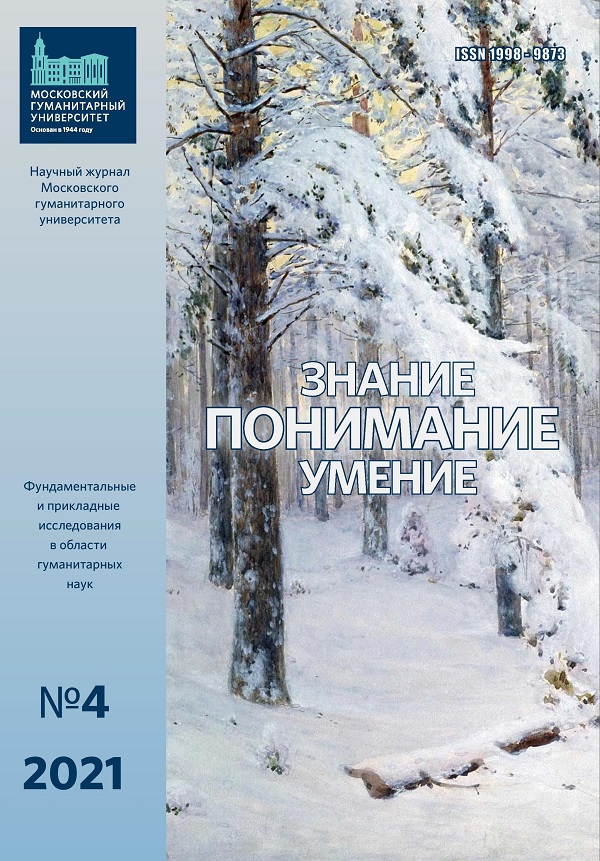Main page / "Knowledge. Understanding. Skill" Journal / Contents / 2014 / No. 4
Kosinova M. I. The History of Relations between Russian Cinema and Its Audience
(The State University of Management,
Russian State University of Cinematography)
Abstract ♦ Today the Russian cinema has a very low level of public trust, since the post-perestroika crisis of the industry has not, in fact, been overcome to this day. Due to this crisis, the communication between the national cinema and its audience has been disrupted. In this paper we have attempted to suggest a way to bring the audience back to the cinema and help them develop an interest in and love for contemporary Russian cinema. The answer to this question is to be found in the history of cinematography.
We treat the cinema repertoire and the viewer systemically, as two communicating vessels, with a focus on their interaction and interdependence on each other. Our approach is rooted in the practice of comprehensive analysis combining the investigation of representative material typical for arts studies with the so-called "historical narrative" of an encyclopedic type, which sets forth the facts and details related to the history of national cinema and its audience’s perceptions.
The article considers several periods in the history of the Russian cinema, starting with the birth and early development of domestic filmmaking, when love and keen interest of most diverse audiences sealed the success of pre-revolutionary Russian cinema. Our second period comprises Soviet-time filmmaking, the history of which easily fits into the socio-political history of our country, and is therefore uneven: a rise is followed by a fall, and correspondingly, relations between cinema and audiences change. Lastly, it is the perestroika and post-perestroika period, when the link between those two parties almost disintegrated.
We can thus conclude that in order to find success with the audience, contemporary cinema should go back to its roots and to use the techniques of the 1930s or 1960s. Filmmakers should not blindly meet the audiences’ demands, but to shape them by means of a competent repertoire policy. Finally, cinema should not only entertain, but also inform, educate, etc. as it did in the Soviet times.
Keywords: cinema, repertoire policy, viewer, cinema audience, cinema attendance, film distribution.
Kosinova Marina Ivanovna, Candidate of Philosophy, Associate Professor, Department of Management in Culture, Film, Television and Entertainment Industry, State University of Management; Associate Professor, Department of Producing Skills and Management, Russian State University of Cinematography; Member, Union of Cinematographers of the Russian Federation. Postal address: 99 Ryazansky prospect, Moscow, Russian Federation, 109542. Tel.: +7 (495) 371-23-88. E-mail:
kosimarina@yandex.ru

Citation: Kosinova, M. I. (2014) Istoriia vzaimootnoshenii otechestvennogo kinematografa so zritel'skoi auditoriei [The History of Relations between Russian Cinema and Its Audience]. Znanie. Ponimanie. Umenie, no. 4, pp. 147–155. (In Russ.).
Submission date: 20.08.2014.
RUSSIAN VERSION
REFERENCES
Ginzburg, S. (1963) Kinematografiia dorevolutsionnoi Rossii [Russian Cinema before the Revolution]. Moscow, Iskusstvo Publ. 406 p. (In Russ.).
Dialog o segodneshnem kino (S simpoziuma vo VNII kinoiskusstva) [Dialogue on Today's Cinema (A Symposium at the Research Institute of Cinematography)]. (1989) Moscow, All-Union Research Institute of Cinematography, Goskino SSSR Publ. 151 p. (In Russ.).
Zorkaya, N. M. (1976) Na rubezhe stoletii. U istokov massovogo iskusstva v Rossii v 1900–1910 [At the Turn of the Century: The Origins of Mass Art in Russia, 1900–1910]. Moscow, Nauka Publ. 303 p. (In Russ.).
Istoriia kinootrasli v Rossii: upravlenie, kinoproizvodstvo, prokat [The History of the Film Industry in Russia: Management, Production, Distribution] (2012) /ed. by V. I. Fomin. Moscow, Ministry of Culture of the RF, All-Russian State Institute of Cinematography Publ. 2759 p. (In Russ.).
Zezina, M. (2004) Kinoprokat i massovyi zritel’ v gody “ottepeli” [Film Distribution and the Mass Audience during the “Thaw”]. In: Istoriia strany. Istoriia kino [The History of the Country. The History of Filmmaking] / ed. by S. S. Sekirinskii. Moscow, Znak Publ. 496 p. Pp. 389–412. (In Russ.).
Medvedev, A. (2001) Territoriia kino [The Territory of the Cinema]. Moscow, Vagrius Publ. 288 p. (In Russ.).
Mikhailov, V. P. (1998) Rasskazy o kinematografe staroi Moskvy [Tales of Old Moscow Cinematography]. Moscow, Materik Publ. 280 p. (In Russ.).
Fenomen massovosti kino [The Phenomenon of Mass Cinema] (2004) / ed. by M. I. Zhabskii. Moscow, Ministry of Culture ; Research Institute of Cinematography Publ. 367 p. (In Russ.).
|
|
|
 The No. 4 2021 of the
The No. 4 2021 of the
Journal "Knowledge.
Understanding. Skill"
is issued
|
|
|
|